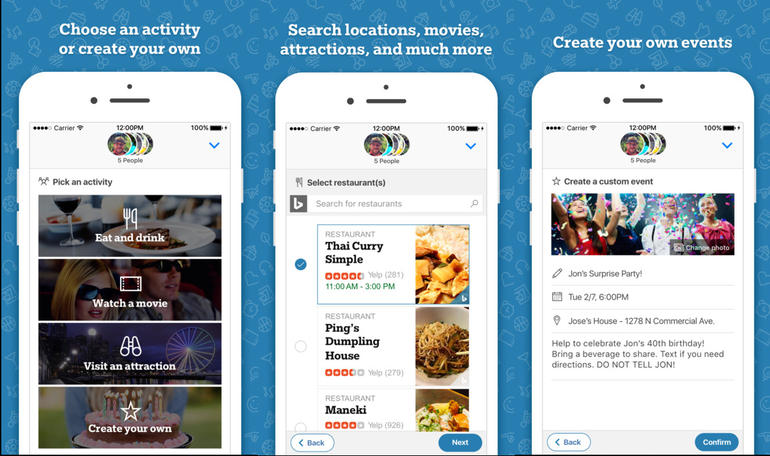

The Who’s In app comes with with common social events but there’s also a custom ‘create your own’ option.
Image: Microsoft
Microsoft is expanding its support of Apple’s iOS beyond Office with a new free social-planning app called Who’s In, designed just for Apple’s iMessage.
Who’s In aims to make life easier for iPhone users who regularly plan their events over iMessage with their iPhone-owning friends.
The app is preloaded with common social events like heading to the movies, dining out, and visiting an attraction. For people hosting their own event, there’s a custom ‘create your own’ option, which allows you to set a time and place, and then invite guests via iMessage.
At the heart of the Who’s In app is Microsoft’s Bing search engine. After picking an activity with the app, it uses Bing for searching restaurants, movie times, and attractions.
Restaurants can be searched by food type, location, or price. The movie option offers reviews and ratings, and uses cards to display and link to timetables.
For now, the Who’s In app is only available if you’ve got a US iTunes account.
As TechCrunch notes, each event gets its own card that’s designed for sharing on iMessage. It displays an image, along with the date, time, and place of the event. Recipients then vote on the question ‘Who’s In?’. A thumbs-up indicates they’re in and a thumbs-down says they’re not.
The voting feature is enhanced by allowing the event organizer to set multiple dates and times to gauge preferences among the group. This facility should help cut the number of messages required to reach consensus.
While the app could be helpful for people with busy social lives, there is a chance it will simply get lost in the iMessage app store.
The app arrives as developer interest in the iMessage App Store appears to be waning and follows complaints over the store’s design.
A report out earlier this month from app analytics firm Sensor Tower counted a total of nearly 5,000 iMessage apps since its launch last September. However, growth in new apps has been steadily falling and reached a low of nine percent in the January-to-February period.
The most common iMessage apps were games, followed by entertainment, utilities, social networking, and photo and video.

